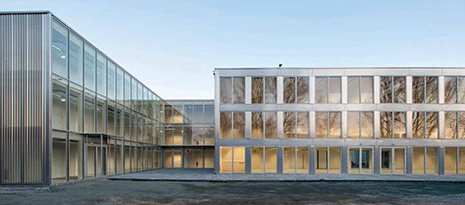Description
There has been a European School in Frankfurt am Main since 2002, attended primarily by the children of employees of the European Central Bank. The school in the Niederrad district of Frankfurt am Main had exceeded its capacity for quite some time and several temporary container-classrooms were already in use on the school grounds. The architects were approached to design a new extension in December 2013 and by April 2014 a plan for accommodating an additional 400 pupils was approved. The architects proposed that the school do more than add further stacked classroom containers and build an actual building using prefabricated wooden room modules. The contract was awarded to Kaufmann Bausysteme from Reuthe in Vorarlberg, a company with extensive experience in modular timber construction. Consequently, the majority of the modular construction was prefabricated in their Austrian factory in Styria: 98 wooden room modules for 17 classrooms, sanitary rooms and stairwells, complete with walls, ceilings and windows, sanitaryware, radiators and electrical wiring. The modules were transported by lorry, which limited the width of the modules to three metres. The most suitable module size was 3 × 9 metres and each of the approximately 75 m² square classrooms comprises three such modules: two modules with façade panels at either end, a long side wall made of cross laminated timber on one side and a full-span beech beam on the other, and a central module with façade panels but no walls, only two beams on either side. The ancillary rooms, stairwells and sanitary rooms are each only a single module in size. On site in Frankfurt, the modules then only need to be stacked next to and on top of one another on a concrete foundation slab. The logistical feat involved ensuring that the 98 lorryloads arrived on site in the right order over a period of three and a half weeks, after which the shell of the building was complete.
Architects and timber construction companies have always had to pragmatically weigh the pros and cons of complete prefabrication, partial prefabrication or the “traditional” on-site assembly of cut elements. Economy, manageability and ultimately also design aspects play a role in determining which is most suitable. In the case of this school, for example, the room modules in the workshop were already fitted with the windows, but the façade cladding – insulation and aluminium sheeting – was only installed after all the modules had been assembled on site. The same applied to the glazing along the corridors, and the linoleum flooring which would otherwise have had to be covered to protect it from damage. For the large activities room on the ground floor, which at twelve metres is three metres deeper than the classrooms, the decision was made not to use timber construction – due to the wide span of the beams – and the ceiling is now borne by steel beams painted white.
The result is a school with well-proportioned and well-lit classrooms and access areas. In fact, the modular grid means that the three-metre-wide corridors are unusually generous for modern school buildings. Despite the rigid module, at no point does the construction principle become obtrusive in the interiors. Although one can clearly see that each classroom is made of three modules, they are perceived as a whole and not as three pieces assembled into one.
The decision to provide three staircases means that there are sufficient escape routes meaning the wooden surfaces can remain exposed without additional fire cladding. Alongside stained spruce and beech, the material palette includes grey linoleum and wood-wool ceiling panels. The extension was completed on schedule within a timespan of just three months, and at a cost of 5.1 million euros was also comparatively inexpensive.
Originally published in Bauwelt 21.2015, pp. 16-25, abridged and edited for Building Types Online, translated by Julian Reisenberger
Drawings
Site plan, scale 1:4000
Ground floor, scale 1:500
2nd floor, scale 1:500
3rd floor, scale 1:500
Cross section, scale 1:500
Longitudinal section, scale 1:500
Axonometric view of the structural system
Photos
 Exterior view
Exterior view
 Interior view of hallway
Interior view of hallway